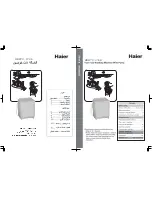
Rev: April 2015
14 of 18
®
BEAST Electric Pressure Washers
MAINTENANCE
GENERAL MAINTENANCE RECOMMENDATIONS
The pressure washer warranty does not cover items that have been
subjected to operator abuse or negligence. To receive full value from the
warranty, the operator must maintain the pressure washer as instructed
in this manual.
NOTE:
Should you have questions about replacing components on your
pressure washer, please call
[1] 919-550-3221
for assistance.
All maintenance in this manual should be made at least once each
season.
Before Each Use
1. Check water inlet screen for damage.
2. Check high pressure hose for leaks.
3. Check detergent siphoning tube and filter for damage.
4. Check spray gun, nozzle extension, and nozzles for leaks.
5. Rinse out garden hose to flush out debris.
The high pressure stream of water that this equipment produces
can pierce skin and its underlying tissues, leading to serious
injury and possible amputation.
NEVER repair high pressure hose. Replace it.
Replacement hose rating MUST exceed maximum pressure rating
of unit.
WARNING
Check Detergent Siphoning Tube
Examine the filter on the detergent tube and clean if clogged. The tube
should fit tightly on the barbed fitting. Examine the tube for leaks or
tears. Replace the filter or tube if either is damaged.
Check Gun and Nozzle Extension
Examine the hose connection to the spray gun and make sure it is
secure. Test the trigger by pressing it and making sure it springs back
into place when you release it. Put the trigger lock in the on position and
test the trigger. You should not be able to press the trigger.
Check High Pressure Hose
The high pressure hose can develop leaks from wear, kinking, or abuse.
Inspect the hose each time before using it. Check for cuts, leaks,
abrasions or bulging of cover, damage or movement of couplings. If any
of these conditions exist, replace the hose immediately.
Adjustable Nozzle Maintenance
Surging, or pulsing sensation, felt while squeezing the spray gun trigger
may be caused by excessive pump pressure. The principal cause of
excessive pump pressure is a nozzle clogged or restricted with foreign
materials, such as dirt, etc. To correct the problem, immediately clean
the nozzle using the tools included with your pressure washer and
follow these instructions:
1. Shut off pressure washer and turn off water supply.
2. Depressurize unit by squeezing trigger with wand away from face.
3. Remove wand from gun
4. Use needle included in kit to free any foreign material clogging or
restricting spray tip, see Figure below.
Connections
Connections on pressure washer hoses, gun and spray wand should be
cleaned regularly and lubricated with non-water soluble grease.
Adjustable Nozzle
For the adjustable nozzle, you can also lubricate the nozzle collar (high-
pressure low-pressure) by using non-water soluble grease regularly.
Water Filter Screen
The pressure washer is equipped with a water inlet filter that prevents
debris going into the pump. If the filter is not kept clean, the flow of
water to the pressure washer will be restricted and the pump may be
damaged.
1. To clean the screen, remove quick connector and remove the filter
screen from the pump inlet.
O–Ring Maintenance
Through the normal operation of your pressure washer, o–rings, which
keep the connections of the hoses and spray gun tight and leak–free,
may become worn or damaged. They should be lubricated with non-
water soluble grease.
2. Rinse filter screen with warm water until it is free of debris and
blockage. Check for any damage, replace if damaged.
3. Reinstall screen and quick-connector immediately.
Air Vents
The air vents located on the front and back of the pressure washer must
be kept clean and free of any obstructions to ensure proper air-cooling
of the motor during operation.
The high pressure stream of water that this equipment produces
can pierce skin and its underlying tissues, leading to serious
injury and possible amputation.
NEVER repair leaking connections with sealant of any kind. Replace
o-ring or seal.
WARNING




































